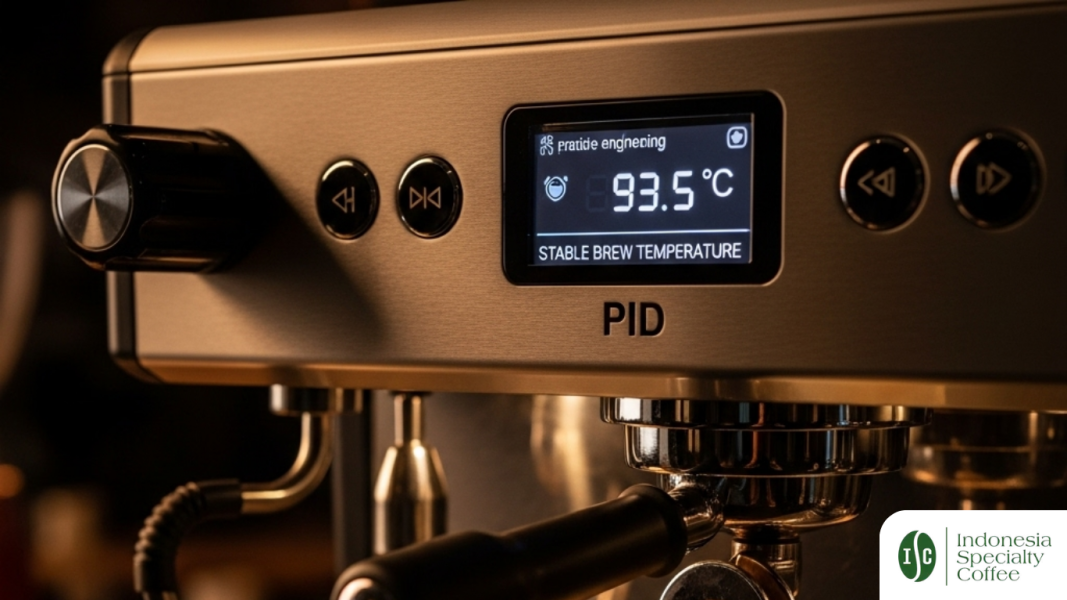You’ve probably had this moment: you’re at your favorite café, sipping a beautifully balanced espresso that tastes like chocolate, citrus, and something warm and floral—all at once. Then you try to replicate it at home. But the shot tastes bitter. Or sour. Or just flat.
What went wrong?
Often, it comes down to one invisible but powerful factor: temperature stability. And that’s where a PID control espresso machine comes in—a feature now essential in modern espresso brewing. PID, short for Proportional-Integral-Derivative controller, is the quiet hero keeping your espresso’s boiler at the perfect temperature while brewing.
In this article, we’ll break down what PID is, how it works, and why Indonesian coffee lovers and specialty roasters should care. Whether you’re a barista, a homebrewer, or a café owner, understanding PID can mean the difference between a great shot—and a forgettable one.
Learn more about how to brew specialty beans like Kopi Luwak properly or explore how Indonesia’s coffee industry is evolving for a deeper appreciation.
What Is a PID Control Espresso Machine?
How PID Stabilizes Espresso Machine Temperature
PID control is like a thermostat—but smarter. Instead of just turning heat on or off, a PID controller adjusts the boiler temperature continuously and precisely, correcting any deviation before it affects your brew.
Think of it as cruise control for heat.
Why PID Temperature Control Is a Must-Have
Espresso extraction is incredibly sensitive. A change of just 1°C can shift your coffee’s flavor from sweet and syrupy to bitter or hollow. PID ensures temperature doesn’t swing during brewing. It’s not just a gadget; it’s a foundation for flavor consistency.
Without PID:
- Boilers overshoot or undershoot target temps
- Heat surges cause bitter or sour notes
- Repeated shots vary in taste
With PID:
- Boiler heat stays stable to within fractions of a degree
- Every shot tastes nearly identical
- You can fine-tune temperature to highlight specific flavor notes
How PID Controllers Work in Espresso Machines
PID stands for:
- Proportional: Reacts to the current error (difference between desired and actual temp)
- Integral: Looks at past errors over time and corrects cumulative mistakes
- Derivative: Predicts future errors and smooths reactions
These three elements work together to keep the temperature rock-steady. It’s math-driven precision, applied to something as soulful as espresso.
A Real-World Example in PID Espresso Brewing
Imagine roasting coffee beans with complex citrus and floral notes. To highlight those delicate flavors, you set your brew temp to 93.5°C. A non-PID machine might swing between 91°C and 96°C. But with PID? You get consistent 93.5°C, every time. That’s how you capture nuance in the cup.
Why Indonesian Roasters Need PID Control Espresso Machines
Indonesia is home to some of the world’s most diverse and exciting specialty coffees—from the fruity elegance of West Java to the earthy complexity of Sumatra. These beans deserve to be brewed with precision and care.
For roasters and baristas working with Indonesian beans:
- PID lets you unlock origin character
- You can experiment with brew temps to optimize flavor
- It helps maintain quality across different baristas or locations
Read our guide to Aceh Gayo coffee characteristics to see how PID brewing precision enhances regional flavor notes.
What to Look for in a PID Espresso Machine
If you’re shopping for a new machine, here are key features to consider:
- Adjustable PID Settings: Can you fine-tune temp for different beans?
- Digital Display: Easy monitoring of brew and steam temps
- Dual Boiler or Heat Exchanger System: Works better with PID for multi-tasking
- Proven Stability: Check reviews or specs for degree of temperature variance
Some popular machines with PID in Indonesia include:
- Lelit Bianca
- Rancilio Silvia Pro X
- Breville Dual Boiler
- ECM Mechanika Max
Want to Dive Deeper? Learn About PID Tuning in Coffee Roasting
If you’re already convinced that PID is essential for stable brewing temperature, here’s something even more interesting: PID control is also a game-changer during the coffee roasting process. Fine-tuning heat during roasting brings out the unique flavors of Indonesian coffee—from balanced acidity to complex aftertaste.
Curious how PID tuning works for roasting machines, and how it helps unlock the best in local beans?
Read our full guide to PID Tuning for Coffee Roasting here.
Why PID Control Espresso Machines Matter
In the world of espresso, small changes make a big impact. PID temperature control might seem technical, but its result is deeply human: better flavor, every time.
If you care about coffee quality, whether you’re a weekend home barista or a high-volume café owner, PID isn’t optional anymore—it’s essential.
So next time your shot tastes exactly how you wanted, ask yourself:
Is it the coffee—or the control behind it?
Takeaway: A PID control espresso machine is more than a feature—it’s a game-changer for brewing consistency and flavor clarity. Learn it, use it, and your coffee will shine.
Explore how specialty coffee is transforming Indonesia or how green coffee beans are graded for more insight.

